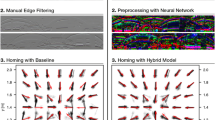Abstract
Reconstruction of a three-dimensional scene using images taken from two views is possible if the relative pose of the cameras is known. A traditional approach to estimating the pose of the cameras uses eight pairs of corresponding points and involves the solution of a set of homogeneous equations. We propose a multi-layered feedforward network solution. Empirical results demonstrate the feasibility of using the network to recover the relative pose of the cameras in the three-dimensional world.
Preview
Unable to display preview. Download preview PDF.
Similar content being viewed by others
References
Hartley, R., Zisserman, A.: Multiple View Geometry in Computer Vision. Cambridge University Press, Cambridge (2003)
Huang, T.S., Faugeras, O.: Some properties of the E matrix in two-view motion estimation. IEEE Trans. Pattern Analysis and Machine Intelligence 11, 1310–1312 (1989)
Ma, Y., Soatto, S., Kosecka, J., Sastry, S.S.: An Invitation to 3-D Vision. Springer, New York (2004)
Zhang, Z.: A Flexible New Technique for Camera Calibration, Microsoft Technical Report MSR-TR-98-81 (1998)
Author information
Authors and Affiliations
Editor information
Editors and Affiliations
Rights and permissions
Copyright information
© 2006 Springer-Verlag Berlin Heidelberg
About this paper
Cite this paper
Benton, R.G., Chu, Ch.H. (2006). Camera Pose Estimation by an Artificial Neural Network. In: King, I., Wang, J., Chan, LW., Wang, D. (eds) Neural Information Processing. ICONIP 2006. Lecture Notes in Computer Science, vol 4233. Springer, Berlin, Heidelberg. https://doi.org/10.1007/11893257_68
Download citation
DOI: https://doi.org/10.1007/11893257_68
Publisher Name: Springer, Berlin, Heidelberg
Print ISBN: 978-3-540-46481-5
Online ISBN: 978-3-540-46482-2
eBook Packages: Computer ScienceComputer Science (R0)




